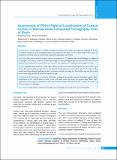Please use this identifier to cite or link to this item:
https://hdl.handle.net/20.500.14356/904| Title: | Assessment of Direct Signs of Localization of Central Sulcus in Normal Axial Computed Tomography Scan of Brain |
| Authors: | Thapa, Bikash Raj Benjankar, Rajbabu |
| Citation: | ThapaB. R., & BenjankarR. (2022). Assessment of Direct Signs of Localization of Central Sulcus in Normal Axial Computed Tomography Scan of Brain. Journal of Nepal Health Research Council, 20(02), 441-446. https://doi.org/10.33314/jnhrc.v20i02.4091 |
| Issue Date: | 2022 |
| Publisher: | Nepal Health Research Council |
| Keywords: | Central sulcus Computed tomography Pars marginalis Precentral sulcus Postcentral sulcus |
| Series/Report no.: | April-June, 2022;4091 |
| Abstract: | Abstract Background: Central sulcus is relatively constant in anatomy and provides an important landmark in lesion localization in high convexity-parasagittal region. The purpose of this study was to evaluate various direct signs of localization of central sulcus in normal axial computed tomography scan of brain. Methods: This cross-sectional descriptive study was conducted in 377 patients with normal findings in computed tomography scan of brain. Anatomic relationships of high convexity-parasagittal gyri and sulci that form the base for signs used for localization of central sulcus were assessed. The frequency of visualization of each sign was noted. Results: Sigmoid shape “hook” of central sulcus (87%) was the most frequent sign followed by pars bracket sign (85%), thin postcentral gyrus sign (84.5%) and superior frontal sulcus-precentral sulcus sign (81.3%). Most of the central sulcus signs showed significant positive correlations with the increasing age. Pars bracket sign was the second most common sign and did not show correlation with age. Conclusions: In the absence of anatomic distortion, computed tomography anatomic techniques usually allow identification of the central sulcus on axial section with most useful sign being the sigmoid shape “hook” sign. Application of these signs in combination rather than in isolation helps to identify with near certainty the location of the central sulcus in axial plane. Keywords: Central sulcus; computed tomography; pars marginalis; precentral sulcus; postcentral sulcus |
| Description: | Original Article |
| URI: | http://103.69.126.140:8080/handle/20.500.14356/904 |
| ISSN: | Print ISSN: 1727-5482; Online ISSN: 1999-6217 |
| Appears in Collections: | Vol 20 No 02 Issue 55 April-June, 2022 |
Files in This Item:
| File | Description | Size | Format | |
|---|---|---|---|---|
| 4091-Manuscript-29694-1-10-20221103.pdf | Full Article. | 341.22 kB | Adobe PDF |  View/Open |
Items in DSpace are protected by copyright, with all rights reserved, unless otherwise indicated.
